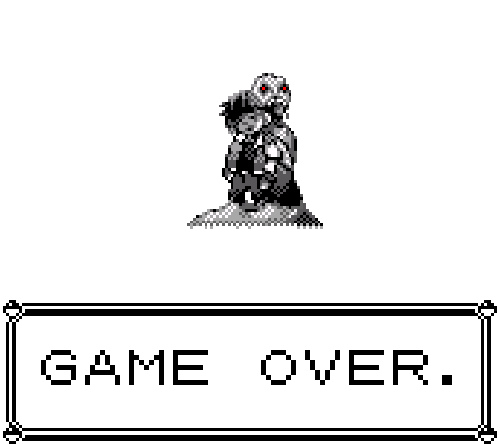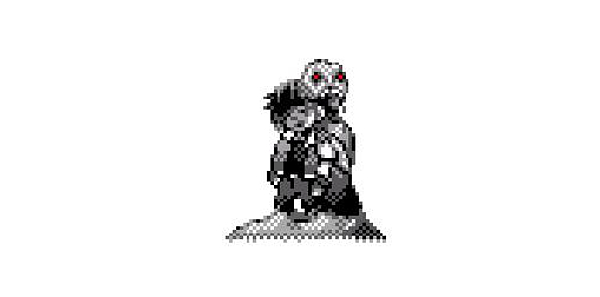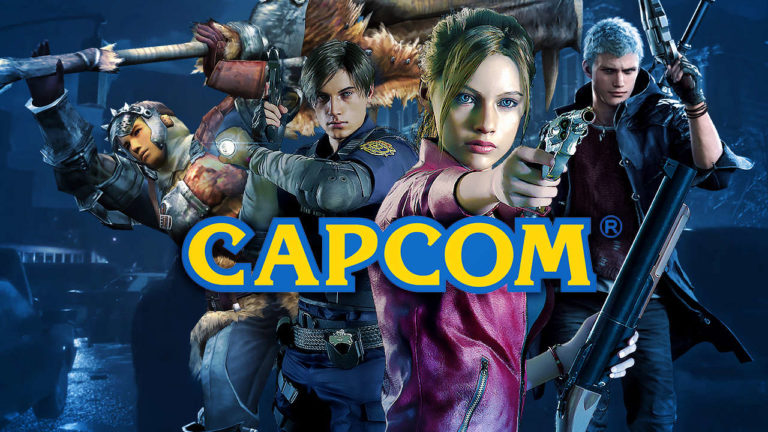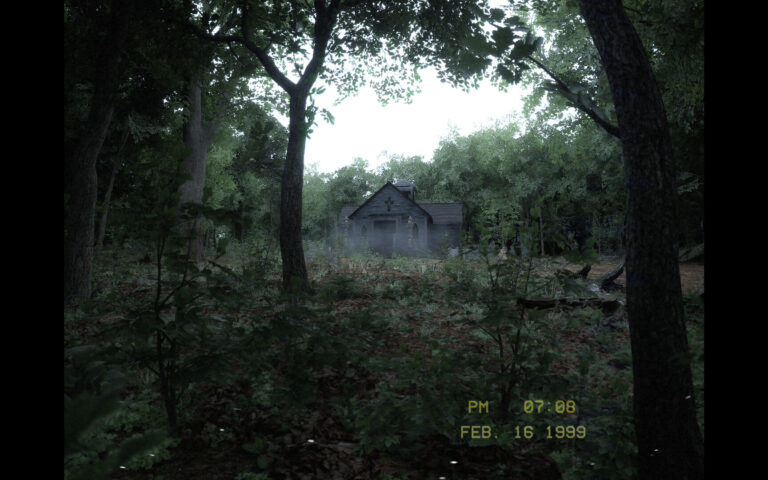I have a certain love for exploring the ways in which non-horror games can scare the player just as much as a good Silent Hill or Dead Space, but for the longest time the problem with recording these researches was the format. My original idea was to explore the horror-related content in The Legend of Zelda franchise, but what quickly ended up happening was that I had to keep summarizing the events of the plot for maybe two to three scenes spread throughout each game. While I am trying to untangle that mess of an article, I hereby present you with something more focused, namely a dive into the world of Pokémon.
I’d be lying if I claimed to be the biggest fan of the franchise; handhelds and I have a somewhat complicated relationship and console iterations have never been that fantastic. I naturally played them as a kiddo though, teamed up with Pikachu I set out on an adventure to… do something. I was about five, I didn’t speak English and I couldn’t even read to begin with, so my journey was a confusing one. Still, the section we are going to talk about today doesn’t require any reading-skills to understand.
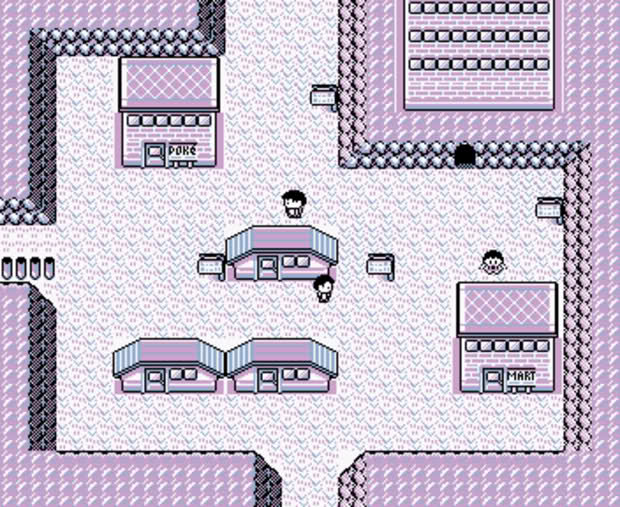
I briefly went over Lavender Town in a previous top ten, but that hardly did it justice. It’s a pretty small and simple town whose only landmark is the giant tower located in the north-east corner of the map. You don’t really need to speak with any characters to progress through this area either; all you have to do is climb the tower. You’re progress will be inevitably be halted, though, and thus you leave the tower and search for a solution elsewhere. A solution is found in the next town and you can finish your ascend after that, which leads you to a boss-fight and a brief pay-off. Without the themes that provide context, it sounds like a very basic setup.
The tower in question is however a massive grave-site, which is about as a big of a tonal-shift as you can get. Creating a world filled to the brim with lovely and cuddly creatures is all fine and dandy until you remind all the boys and girls out there that even they can die horrible deaths. One such horrible death befell upon a Marrowak, who protected her young from the evil crime syndicate that tried to steal her children. Her ghost and presumably those of other Pokémon killed by Team Rocket now haunt the tower and possess any humans that try to enter.
That alone is pretty screwed up, but then there is also the uncanny nature of the town itself and the famously creepy music. The music is especially notable because it has made the area in a bit of an urban legend itself, which of course means there are also a ton of good “Creepy Pasta” stories based on it. While there are plenty of variations, the main story behind the music is that it experimented with high frequencies and this caused children to develop illnesses and afflictions or even kill themselves. I will post a video with the music below, but I don’t recommend listening to it due to the obnoxious beeping sounds. It probably won’t kill you, but the sounds are annoying anyway.
Now the first Pokémon games were released in 1996 on the original Game Boy, so Game Freak had to cut down the story due to the technology. There are some very clever and subtle hints inside the game, though. First of all, the name of the town itself, “Lavender”, is the name of a color. Every town in the original Pokémon was named after a color (Pewter, Cerulean, Viridian) and this particular one is a pale violet. There is nothing truly off about that, but Lavender is also the name of a flower. If we were to delve into the art of floriography, we would learn that lavender flowers mean either devotion ooooooooooooooooor Distrust. We’ll get back to that in a minute.
Even with such symbolism, the Gameboy still limited the story. To discover more about the tale that Game Freak really wanted to tell, we are going to take a peek at some of the other versions of this story. Our first stop is Pokémon Adventures, a manga-series based on the games. While there are different manga out there and hundreds of fan-stories, this one deserves to be credited since Pokémon creator Satoshi Tajiri himself has gone on record saying: “This is the comic that most resembles the world I was trying to convey.”
The manga follows the character of “Red” and reiterates the events of the game while also introducing numerous changes. The Tower in Lavender Town is visited in round 13 and 14 of Chapter 1, which served as the ending of the first volume. The rounds are titled “Sigh for Psyduck” and “That Awful Arbok”. During these two rounds, Red arrives in Lavender to find that all the villagers ignore him and his questions. He eventually runs into an old man who explains that ghosts have started to haunt the tower and as a result, people have started to mistrust each other, fearing that their old neighbors could be possessed or hallucinations. This is where my earlier-made floriography story comes back into play and it suggests that those uncanny people in the game were actually under the influence of various ghost-type Pokémon or didn’t even exist at all and were hallucinations that the player-character was undergoing.
The manga is already a little more brutal than the game itself and Pokémon deaths are a lot more common, but here it’s taken to a literal (and unsubtle) extreme. After Red hears that his rival has headed into the tower already he goes there himself and finds – are you ready for this? – Zombie Pokémon. Yep, there are zombies in Pokémon now. Ever read any of those crappy Creepy Pasta stories where Pokémon sprites turn into mutilated versions of themselves? Those might not be as unrealistic as you’d think.
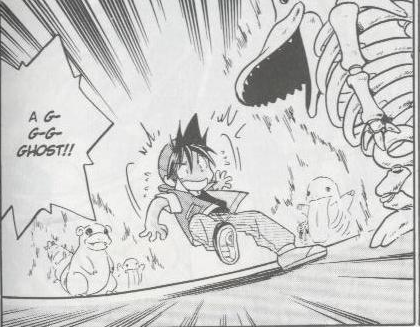
“Sigh for Psyduck” proceeds with Red entering the tower and been assaulted by the zombies, which features some rather disturbing imagery. After failing to find a weak-spot for some time, Red discovers that a Ghastly (a ghost-type Pokémon described in Chapter 52 of the manga to be born out of smog) was controlling the corpses. The Round then ends on a shot of Red’s rival “Blue” showing up in a possessed state. Red eventually finishes off the Ghastly and he then teams up with his rival to climb the tower and fight the last evil Pokémon present there. Doing so liberates the town and restores the peace.
So far this has given us two different interpretations of the town; one an unsettling Silent Hill-esque dot on the map and the other a zombie-fest that relies on imagery. What both versions have in common however is that they use their characteristics to stand out amongst the other towns we see in the story and, in doing so, toys with the audience’s perception of the Pokémon universe. In the games it is the atmosphere and subject matter that surprise the player and in the manga it is the gore. Our final stop is a disappointing one however, simply because it doesn’t achieve the same result and misses the point of Lavender Town by doing so.
The anime is the version of this story that pretty much anybody who was born in the 90’s or late 80’s (or the parents unfortunate enough to have kids who were born in that period) will be familiar with. It follows Ash, Brock and Misty as they do their best to get Ash into the Pokémon League by beating the eight gyms of Kanto. The anime takes a lot of liberties with the plot, though, even going as far as to create their own protagonist instead of using the default one. The episodes that deal with Lavender Town are #22 “Abra and the Psychic Showdown”, #23 “The Tower of Terror” and #24 “Haunter versus Kadabra”.

To be quite honest, the only episode where Lavender Town is actually visited is 23 and the others take place in Saffron. Episode 23 however has very few horror elements, since it’s more focused on comedy if anything else. The crew arrives at the tower, which has been reworked as a mansion as opposed to a graveyard. That is already rather jarring, since it shows that the creators didn’t really have the guts to tackle this area the same way everybody else did it. The only significant scene that takes place is that Ash is temporarily killed so that he can float around as a ghost for a while, this however has no lasting effects on him and to my knowledge it is never again brought up anywhere in the entire anime. That is literally it, the town is never again shown, nor do the characters ever interact with the townsfolk.
This naturally begs the question: “Then why did you bring it up?” My answer to that would be because there is actually some interesting material in the other two episodes which take place in Saffron City. The gym leader known as Sabrina resides there and she is established as a mighty psychic who the character of Ash has to overcome. The fact that he can’t beat her is also his motivation to visit Lavender in the first place. What makes Sabrina interesting as an opponent is her violent nature; at the very start of the episode she attempts to murder Ash by luring him through the fog to a dangerous cliff. After arriving at her gym and been led to her arena, her servant addresses her and is then chocked briefly as punishment for his choice of words. It’s interesting that such violence was allowed to stay in the final product, especially when you consider that the notorious 4Kids Licensing Company was responsible for the translation and censorship of the English version.
That is sadly all that we can get from the anime and besides shining a little light on a central character, that is relatively little. It is however enough to complete a picture of Lavender Town and the way it has been portrayed over the years. In conclusion I’d like to say that I wish more companies were like the ones behind Pokémon Adventures and the ones working at Game Freak; People who don’t look at kids like mindless drones that you need to put before flickering lights. Just because your product is marketed to kids it doesn’t instantly mean that you should think inside the box yourself, Lavender Town is a clear example of that. Both the game and the manga did something truly unique with it and that has allowed it to stand out as a memorable bit; the anime however took the easy way out and I have to admit that I didn’t even recall the episodes in question.
